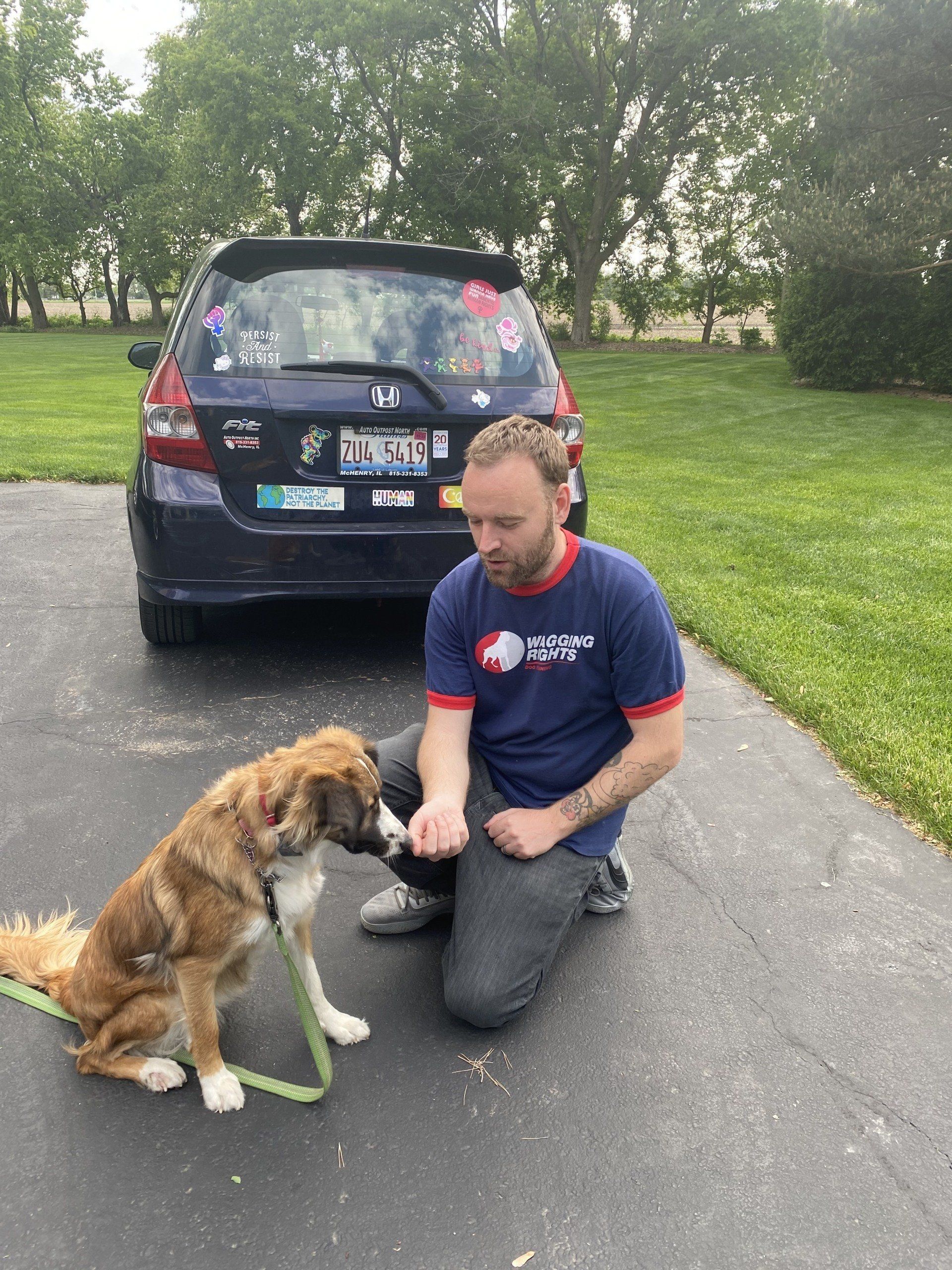POSITIVE ONLY TRAINING FLAWS
This is an article I have been working on for the past few weeks. It points out the flaws of positive only training methods and describes in great detail why you need corrections in dog training. If you enjoyed this article or learned something from it please share. The more people that receive this message the better the world will be for dogs and their owners.
Thank you
First off I want everyone who reads this article to understand my motivation behind writing this, certain tools ( such as prong collars and electronic collars) are being banned across the globe and dogs are being euthanized for behaviors that could easily be fixed. Did you know in America over 1 million dogs that come through animal shelters get euthanized every year? It’s impossible to know the exact reasons why all dogs wind up at the shelter, but it’s safe to assume that dogs are not being given away due to good behavior. That’s not even counting the ones that get sent straight to the vet...
For those of you who do not know me or haven’t seen me train don’t assume by this article that I am a heavy handed, yank and crank, old school trainer, that is gung ho about punishment and thinks every situation is solved with punishment. I simply know when and why to reward and when and why to correct and always aim to correct in the lightest fashion possible. I believe in being open minded to anything that can help me help dogs and in turn help their owners. I believe the more options you have, the more capable you are as a trainer.
I am growing increasingly concerned about the message “pure positive “ training advocates are spreading and how bold and aggressive they can be in their attacks on other styles of training. I understand that a good portion of this following, probably the majority are good hearted people who truly feel they are doing the right thing or at least supporting the right values.
The other portion is drinking the kool-aid, behaving in a cult like fashion and spreading fear and propaganda about tools and training techniques they have no experience with. This fear leads to a generalized uneducated fear from the general public that keeps these myths and wives tails circulating. As you will see later on in this article generalizations and assumptions are not really ever the truth, usually just propaganda skewed in the direction of the person talking. For those of you that fall in that camp I hope this article sheds some light on the other side and how most of us balanced trainers think.
To understand where I’m coming from I feel it’s best you know a bit about me. If you’re a pure positive trainer reading this, I was you... I was determined to train without force or aversives for 5 long years. I started in 2008, went through Animal Behavior College, taught at Petco for a couple of years, got my cpdt-ka certification, met up with other pure positive trainers, shadowed their classes and studied every training dvd I could
possibly get my hands on... I was obsessed with fixing aggression through force free methods. After a while everything I came across was just a reminder of something I already knew, said by a different person. I practiced what I knew for years. I had some success sure, but I realized through early failures that this method of training alone lacked reliability, was too much work on difficult cases to realistically expect clients to be able to do, lacked options when things weren’t working well enough, left options for dogs to not comply with your cue’s and most importantly can be unsafe.
Lately I’ve been hearing a lot of positive trainers talk about how “the science” states punishment will make a dog aggressive, punishment ruins relationships between dog and owner and that positive reinforcement alone is more effective than using punishments, negative reinforcement and positive reinforcement combined... I can tell you first hand that this is the furthest from the truth.
Let’s talk some real stuff here- as I stated earlier, I was a pure positive trainer for 5 years and still study positive reinforcement trainers frequently. I can tell you first hand that this style of training alone with a hyper dog, aggressive dog, reactive dog, very distracted dog etc... is incomplete and can not be completely successful on its own with a majority of dogs. There might be some dogs who are easy and fit the profile for that style of training better, however I’d argue that it doesn’t possess all the answers for the vast majority of dogs. Dogs are like kids in this regard, not every child learns the same way. Classic case of square peg and a round hole.
This is not to say that nothing good comes from positive reinforcement training, many great techniques have come from positive reinforcement training and overall I believe it has benefited the industry by making trainers more thoughtful and gentler in their approach to training. Matter of fact I lean way more towards the positive reinforcement side of things than the traditional style of training ( escape/avoidance training that doesn’t use food). I simply believe there are circumstances that call for more than just positive reinforcement training to fix behavioral problems, to make obedience more reliable and ultimately increase our dogs overall safety.
Some people have claimed to have fixed problems with pure positive methods, but when you ask them about it, there are always certain stipulations to it and it usually takes them months to years to even get there. I am not an advocate for lazy training by any means, it’s just that in some scenarios you’re experience leads you to know better and you can get to the same result skillfully and smoothly without spending months or years. Would you rather ride a bike to work or drive a car? Use a screwdriver or a drill? You learn through your experience and become an expert. No “humane hierarchy” should govern the way that you train. Especially if you follow one that has death before discomfort... I honestly can't even believe people are so extreme that a thing like this exists... you can call yourselves humane all you want, but when you are killing instead of correcting, you need to look in the mirror.
Don’t get me wrong I use positive reinforcement to teach new behaviors all the time as it is the best way to teach new things to dogs. It is even incredibly useful when working with fearful dogs and can help stop reactivity and fear aggression by counter conditioning and making dogs more comfortable around things they are afraid of. The downfalls of pure positive training comes when you are trying to stop a behavior that is not rooted in fear.
Let’s discuss some examples of how positive reinforcement training on its own can come up short. Keep in mind I see a ton of clients after they didn’t get the help they needed through pure positive methods. For every client that I get who has been to 1 or more trainers, I always ask what training has previously been done and to give me examples of the prior trainers methods. Again the more you know, the more options you have to help. Below are just a few common examples that I see;
If you have a puppy that is an extreme play biter- you can teach leave it, condition your touch, remove the dog or yourself as a social punishment, interrupt and redirect the dog to a toy. All of these suggestions are great, but what if you are in an area like on a walk for example or in the backyard where you cannot get away from the dog? What if they choose not to leave it? What if you don’t have a toy or food on you? This is where you need to step in with an appropriate level of correction.
Spraying the dog with a squirt bottle when they bite and then immediately rewarding once they stop works well, leash pressure when they bite then releasing and rewarding once they stop works well too. If it comes down to it an appropriate level on an e collar works wonders too. Keep in mind I work with dogs that have done this for months or even years, not just puppies. I work with dogs that even though they are not “aggressive “ are grabbing their owners arms, ripping their clothes, scratching and puncturing their skin etc.. Do you think this owner wants to hear “ take your time and teach leave it” or “ignore” it it will go away? Sometimes you have to have the common sense to be more concerned about the owner than the dog. Redirect with a toy or teach leave it are not good answers here and the owner will be frustrated with you and your advice that won’t work here. At the end of the day a dog has to know there is some type of consequence that they want to avoid. Again all of those initial suggestions have their place, but tell that to the 120 lb German Shepherd that played tug with my shirt and terrorized his owners and you will realize some behaviors have to be stopped.
What about the dog who is running on leash as you are trying to walk? You can feed your dog next to you, stop when they pull, turn them around etc. Dogs are faster than us obviously, they become easily distracted by many things out on walks and most of them only view us as an anchor holding them back from fun. Walking is a struggle for pure positive trainers. Matter of fact I always see dogs way in front of positive trainers and I don’t think I’ve ever seen a client of theirs successfully heeling their dog. Bottom line here, you must be able to use spacial pressure, leash pressure, possibly corrections, positive reinforcement and patience. Pulling into a harness is not a solution either... I don’t care if your dog has a trachea issue, that’s not from using a prong correctly btw, that’s from allowing your dog to pull you on a flat collar.
Anybody have a dog that won’t come when called? This one right here has to be 100% reliable for your dogs safety. Pure positive training is honestly dangerous here. Yes, you can get a ton of reps in, make the reward super enjoyable, practice in controlled environments. But what would happen if your child accidentally lets the dog out, the dog sees a rabbit and starts booking it towards a busy street? There is a big difference training with no distractions vs training in the real world. Bottom line here is that you need a way to stop them.
Below is a list of things that I find problematic and will be addressing about pure positive training;
.Value of distraction/behavior compared to rewards
. Lack of control over variable/ distractions
. Risk analysis of time the owner is left frustrated
. Risk analysis of the dogs safety and survival
. Cognitive abilities of dogs compared to people
. Fair punishment vs abuse
. Continuous vs variable punishment
. Studies vs experience
. Parent vs friend/ respect/love
. “Replacement” behaviors
. Don’t be duped by marketing
. Dominance? Alpha? Pack theory?
Value of distraction/behavior compared to rewards.
We have basically 4 things we can reward a dog with- food, play, praise/touch and space. If distractions such as wild animals, cars people coming into your home etc. self reinforcing behaviors such as biting, chewing, jumping and barking have more value to our dogs than what we can offer, we have to have a way to say no.
View it like this ( chart created by Ted from Mango dogs)
P = positive motivator
D = distraction
N = negative motivator
Let’s say we are using food as a positive motivator. Food to this dog has a value of 6 on a 1-10 scale.
P = 6
Let’s say this is a Cattle dog that has a high prey drive and wants to chase cars. The value of chasing a car is a 9
D = 9
Let’s say we have conditioned this dog to an electronic collar and the dogs corrective number is a 30. If 30 on an ecollar is just enough to stop the chasing behavior it is a 10 on our scale of 1-10.
N = 10
In this scenario you can successfully stop this dangerous car chasing behavior. If you didn’t have a negative motivator you would be stuck managing this behavior. You could try to match value of prey drive with toys which can be effective practice, but still when a dog gets distracted and decides to take off is not enough. I would not trust this method with my dogs life at stake. You will always be stuck having to manage this and hope no accidents happen.
In my opinion constant management = a less fulfilling life to the dog. I would gladly create an aversion to chasing cars if it means my dog won’t chase them and therefore will not be ran over. Death is the ultimate price to pay and I’ve sadly had to be a part of a story just like the one above.
Lack of control over variables
This is something that routinely gets glossed over. We have limited control over some distractions in our dogs lives. We can’t control wild animals whatsoever and have limited control over what the general public does. Sure we can make rules with our dogs, however most dog owners fail to clearly communicate their rules to others. We can’t control how people drive, ride their bikes, control their kids or pets either. You see for pure positive training to be successful you have to manage everything carefully and not put the dog in positions where they may fail, though I agree with that statement it again looks great on paper, but isn’t very applicable in daily life. Even if you try very hard to work at the dogs level, real life will occur and there will be setbacks. If we as dog trainers can’t achieve this unrealistic goal what makes you think your clients will be able to? Clients will not be that diligent. There will come a time when the best decision is to stop a behavior through a correction, move a dog out of a bad situation using some form of pressure (spacial, leash, ecollar). Being ready for the unexpected is a part of life- think of how often you’ve had to slam on your brakes because of someone else’s mistake.
Risk analysis of time the owner is left frustrated
Many dogs are given up every year for simple problems such as jumping, play biting or pulling. With shelters and rescues being overfilled with dogs, what do you think happens to them if they don’t get re-homed quickly? I have heard pure positive trainers talk about how they have trained their dogs for literally years on simple issues like greeting guests at the door, pulling on leash and leash reactivity. Again if it takes you months to years as a professional trainer to make a difference in your dogs behavior, what makes you think your clients will commit to doing this. Most people are too stressed and don’t have enough time in their busy schedules to put that much time into training their dogs. Sad, but true. If you leave these owners frustrated without solutions to their problems they are more likely to correct their dogs incorrectly or give them up. You have to weigh out the pros and cons, what’s worse teaching your clients how to give proper fair corrections or years of frustration and poor relationships between dog and owner?
Risk analysis of safety and survival
Unfortunately many things in life can harm or even kill our dogs. Getting into the garbage, chasing wild animals, chasing cars etc can obviously cause harm or death to our dogs. Pure positive trainers act like causing fear is the worst thing you can do to a dog... can you imagine a humans life without fear? We wouldn’t last very long. I’m afraid of bears, jumping out of high windows, driving straight into oncoming traffic, doing hard drugs etc... my point is that it is our job to teach our dogs what needs to be avoided and how to stay safe. There are safe rational ways to create avoidance without ruining your dog. Some fear is good fear and can save your dogs life
Cognitive abilities of dogs vs humans
So why do some forms of punishment have to be physical? Well, there are two forms of punishment negative punishment (removal of something the dog wants) and positive punishment ( adding something the dog finds unpleasant). If you are in a scenario where you can’t give a time out or the dog doesn’t care about your positive motivator you are in a bad position. Example- if your dog is pulling on leash to get to another dog and finds the dog more valuable than the food you’ve trained them off of you can not punish the dog by removing food, you have no way to give the dog a time-out and a dog will not understand removing something they value long term. Removing food your dog does not care about in the moment is the equivalent of this- let’s say you like saltine crackers, but you like a nice medium rare ribeye much more. If someone said if you eat that ribeye I’ll take your cracker, would you care? I know I wouldn’t... also a dog does not have the cognitive ability to understand a long term negative punishment consequence. You can tell a child “if you keep failing math class I will take away your Xbox and cell phone until you have a passing grade” and they will find that to be immensely punishing because those two things have such value to them and most importantly they understand the English language! Well on the other hand you can not tell a dog “if you keep jumping on grandma I’m taking your bones away and no walks for a month” a dog will not in a million years understand that. What they will understand is something unpleasant occurring every time they jump. Ex your dog jumps and you spray them with water from a squirt bottle.
Fair punishment vs Abuse
This is all about how certain tools are used. The assumption by trainers or activists for pure positive/force free training is that balanced trainers are hanging dogs with slip leads, stabbing dogs with prong collars and electrocuting them with “shock” collars... they just refuse to open their eyes and minds to see how they are properly used and how gentle you can be with them. This a not the article to go in depth n how they are properly used- I recently wrote a detailed article on e collars and have dozens of videos for you to see me training. When I show my clients any of these tools and start using them almost all of them are in disbelief that people have such a big issue with their use. To sum up uses of these tools start light and only get harder if necessary. To make a good comparison they are all like driving a car- you can go 10mph, 20mph or 110mph... it’s kinda stupid to assume everyone drives 110mph right? Then don’t assume the worst with these tools especially if you have no experience using them properly.
Continuous vs variable punishment
I recently joined a pure positive dog training Facebook group because I like to have as much knowledge as possible and I believe many good things do come out of positive training. I just believe that in order to help dogs and people as much as possible you have to be open to anything that can help. The post read something like this “ in order for punishment to be effective you should only have to apply it once and the behavior should never come back, so because this isn’t the case positive punishment is ineffective”... come on seriously? I guess food training is the least effective thing in dog training then, that sure as hell doesn’t work on the first try... I went on to detail my experience working with dogs and instead of being open minded they just removed me from their group. This again confirms the fact that they think certain tools have to be used to their full potential and that no one using them has common sense or the skill to read dogs whatsoever. Again is everyone driving 110mph? Just because something has potential to be dangerous does not mean that it can’t be used with common sense and skill. Continuous punishment to me means punishing the same behavior every time it occurs at an effective enough level to make a behavior change in the right direction.
After teaching my dog to heel using food, I layered over leash pressure and spacial pressure. At this juncture in training he has a really good understanding that he should be at my heel on my left side. I’d say he was good about 75% of the time. From there he needed to learn not to step in front of me. Long story short he eventually got corrected with an e collar at .25 percent of its power and he did not pull the rest of the walk. I found this level by reading the dog and seeing where he made a positive behavioral change. 10 underwhelmed him, 15 and 20 underwhelmed him, but 25 made a difference. The next day he pulled and I repeated the process, now about once every 10 walks he needs a reminder. I was incredibly consistent in my approach and never let him pull or accidentally rewarded pulling by allowing him to drag me to anything he was interested in.
People make huge errors by correcting dogs sometimes and not others. If sometimes the behavior works or pays off than they will continue to gamble and try to do whatever you want to stop. And as we all know gambling (random reinforcement) can be very addicting. Compare a dog pulling on a leash to sniff, greet other dogs/people etc to a child misbehaving at toys r us... too soon, I guess we’ll say the toy aisle at target then. If your child throws a tantrum because they want a toy and you tell them no it’s too expensive and 50% of the time you cave and give in, guess what, you just reinforced the tantrum and also taught your kid to try that behavior. Now if right from the start you gave a meaningful punishment like grounded them for a week thy may try you a couple more times to see that you’re serious, but the behavior will not continue long term. You may also see the intensity of the behavior lower throughout the process, showing that it is working, but is not a miracle overnight cure. To sum this up read the dog, start small, find an appropriate level of punishment, be consistent and do not give in ever.
Studies vs experience
If what pure positive trainers say about positive punishment or negative reinforcement is true, then why am I and thousands of other balanced trainers out there not seeing it? They say it damages the relationship, causes aggression, causes long term fear... why are so many people not seeing this? Could it be that pure positive trainers have never learned how to use these tools correctly? Could it be that their “studies” don’t use the tools in the same way a skilled experienced dog trainer would use them? Could it be that they adjust the “studies” to favor their point of view? Are they ignoring other studies that prove them wrong? I am not a scientist, but I can tell you scientists are not out in the real world training dogs. Also half of these studies were done with rats in a controlled environment called a Skinner box... some draw parallels to training dolphins and seals etc at Disney world and zoos, again different species in a controlled environment. For example you don’t walk down the street with your dolphin and have to deal with some idiot who wants to pet your dolphin and your dolphin biting them..or grandma coming over and your walrus deciding to jump on her... see what I mean?
A great example of a study that was used as propaganda-
A few years ago there were a bunch of studies coming out about electronic cigarettes funded by big tobacco and pharmaceutical companies. These studies cranked the e-cig up so high ( beyond a level anyone would use it at) that it burnt out the coil and released carcinogens and other harmful chemicals... no kidding! They released this study and scared a lot of people, which in turn made the news and still to this day people quote the stupidity they heard on the news, whether they watched it directly or heard it through the grapevine- by the way when a study was conducted in an intelligent manner e - cigs proved to be about 97% less harmful than a cigarette.. This sounds eerily familiar right? If you just nonchalantly toss on an e collar, dial it up high and just start pressing buttons you will cause problems. If you just toss on a prong collar and start cranking on it like your chopping wood you will have a problem... couldn’t you use a harness in a real stupid way though too? How about I swing my dog around on it’s harness and let it going like I’m competing in shot put- should we ban harnesses now?
Anyways one could argue training on a daily basis is your own personal “study” and interestingly enough when done in an intelligent manner I see the exact opposite of what they are telling me. Would you believe that having rules and boundaries that can actually be enforced when necessary leads to a dog that respects you and listens to you? Hmm kinda like kids right?
Friend vs parent/ love vs respect
Are you your dogs friend or parent? Serious question, far too often people just become their dogs friends or try to gain their dogs affection. This type of mentality is what gets people in trouble. Have you ever seen a truly spoiled child whose parents just want them to shut up so they do whatever they want. I had a friend like this growing up, his parents gave him everything you could imagine to try to make him happy, but always wound up with a rude, aggressive unappreciative child... The same thing often happens in our relationships with dogs. A dog can enjoy your company and still not respect you, a dog can want what you have and still not respect you
Replacement behaviors
I think this is a great idea and I often use the concept, however I believe it is incomplete on its own. For example, I see many trainers teaching sit to replace the act of jumping. I think this may work in some cases, but not all and I also think the dog gets the message much more clearly when you make jumping even just a little unpleasant. For most dogs replacement behaviors work like this- “ I’ll sit most of the time and still jump here and there” to me that is just not good enough. This would also require heavy management and full cooperation from guests. Also in highly adrenalized moments dogs are not in a “thinking” state of mind, quite the opposite in fact, they are processing things in a completely different side of their brains and often need a way to be redirected back to the thinking side. Ex have you ever had guests over and tried cueing your dog to sit or lay down and it was as if they didn’t hear you til the 10th time you asked? Ever had your dog get loose and have them not respond to your recall til the 10th time you asked?
I also believe that just because you can sit does not mean you won’t jump... Just because I know how to speak Spanish does not mean I won’t speak English. I believe you can see a ton of improvements doing this in a positive only style, but you will get a much quicker more reliable response adding some consequences to jumping.
Don’t be duped by marketing
As I stated previously in this article, many good things have come from positive training and if it were truly as effective as “balanced” training, I think every trainer would be using it and you would seem lazy and careless if you continued to use any aversives in your training. That being said, it isn’t as effective and should not be marketed as such. If the majority of people were getting amazing results with pure positive training, I would have no problems with what those trainers claim and how they sell their programs.. But, most people are not getting those results and the trainers are still claiming their methods are superior. If you can’t back up what your selling that is a problem in any industry.
Here is a little story that helps explain this point. Throughout the past 3 years I constantly get calls from yelp trying to get me to pay for yelp advertising. I asked other trainers I know personally and hundreds on Facebook groups and only a handful of people thought yelp ads were worthwhile. Yelp is on the phone telling me how awesome their service is yet barely anyone I talked to thinks it’s worthwhile. Obviously if the majority of people were telling me yelp will help me and increase my income I’d gladly pay for advertisements, but that was not what I was hearing from their consumers. Point is anyone can say their methods are superior, but if others don’t see the results they claim and often seek out more help from balanced trainers it’s fair to say their methods aren’t as great as they think they are
Their sales pitch has us all duped. When the average consumer hears the term positive, they tend to think of it in an emotional context, when really it just means to add. I know this because I’ve asked many people this, I’ve gotten responses back to the question “what do you think positive training means?” That include, good, friendly, nice, fun etc... Did you know the term positive as in positive reinforcement is derived from operant conditioning and just means to add? That’s the truth, in positive reinforcement training we are “adding” things dogs inherently like to behaviors we want to see more of. There is also positive punishment which means to add something the dog inherently finds aversive when they are doing something we want to see less of... the term positive isn’t so warm and fuzzy now is it.
Conversely, negative just means to remove something or subtract something. It can mean remove pressure as in negative reinforcement or remove something the dog likes as in negative punishment. Again, negative is not good or bad. It just means to remove or subtract.
Dominance? Alpha? Pack theory?
While I don’t believe in a definitive hierarchy or that domesticated dogs are truly pack animals, I do believe that dominance definitely exists. Based off my experience and studies I see dominance in moments, but not perpetual dominance. For example, one dog could guard a toy from another dog, yet still let that other dog go out the door first or lead on walks. Some of this comes down to breed tendencies as well. Ex,
A German Shepherd will generally care a lot more about people on its property than a golden retriever, but that doesn’t mean it is dominant over the Golden.
The dog that jumps up on you, grabs your clothes, starts ripping them, bites you, bites the leash and plays tug with it... that dog is being dominant and needs to learn some respect. You can’t just ignore that and hope it goes away btw, if the dog likes doing that ( and they do) it is a self reinforcing behavior and will continue.
I think the thing to focus on here is that by being a balanced trainer who rewards and corrects does not mean you believe in “pack theory”, always being “alpha” or anything like that. It means you believe in right and wrong, acceptable and unacceptable. My point is the two ideas do not have to always be combined and not all balanced trainers are looking at training through that lens.
As I mentioned previously in this article it is important that your dog does respect you though. If your dog does not respect you than why would they listen to you? Some will say “ you have something they want... believe me you won’t always have something they want. Respect is created through creating trust, keeping them safe, having rules no matter where you go, bonding with them through play and training and staying consistent in your approach. If there are no consequences for not listening to known behaviors then what makes them reliable? You can’t always say “go back to kindergarten “ every time your dog blows you off. It is important to add that there is a difference between learning a behavior and asking for a known behavior. I never correct while learning a behavior, that would be completely unfair.
Last month my dog decided he did not for the life of him want to do a behavior we call “be shy” it’s a simple trick he has been doing for a year and a half where he cover 1 eye with his left paw. There was no doubt in my mind he just felt like being stubborn and he knew what I was asking for 1000%. So I said “no” gave him a chance to respond, even gave him the benefit of the doubt by repeating the cue, said “no” one more time and then corrected him... guess what, he doesn’t hate me, he didn’t turn on me, can you guess what he did?... he gave me the behavior I asked for and hasn’t failed at it since.
I know this turned into an incredibly long read. All I wanted to do here is to provide a voice for balanced trainers who have skill and use all tools wisely. I am not in support of anyone using any tool in a careless, reckless manner. I am for common sense not unrealistic ideologies that govern how people train and can ultimately cause them to make terrible decisions when their solutions don’t work.
Hopefully some of you who read this will spread the message and help keep tools from being banned and keep more dogs well trained and alive.


















